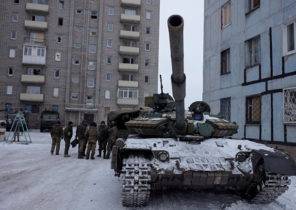Throughout its history, the Earth has been a snowball effect and greenhouse. And if the climate changed before humans, how do we know that we are guilty of sharp warming that is observed today?
Partly because we can draw a clear causal link between anthropogenic emissions of carbon dioxide and rising global temperature of 1.28 degrees Celsius (which, incidentally, is ongoing) compared to pre-industrial levels. Molecules of carbon dioxide absorb infrared radiation, therefore with growth of their quantity in the atmosphere they trap more heat, which evaporates from the surface of the planet.
Paleoclimatology has made great strides in understanding the processes that have led to past climate change. Here are ten cases of natural climate change — in comparison with the current situation.
Solar cycles
Scope: cold by 0.1-0.3 degrees Celsius
Timing: periodic downturns in solar activity stretching from 30 to 160 years, separated by several centuries
Every 11 years the sun’s magnetic field is changing, and with it come the 11-year cycles of brightening and fading. But these small fluctuations on the Earth’s climate is affected only slightly.
Much more important than “large solar minima”, ten-year periods of lower solar activity, occurred in the last 11,000 years 25 times. A recent example, the Maunder minimum, occurred between 1645 and 1715, and led to the fall of solar energy in 0,04%-0,08% below the present average. For a long time scientists believed that the Maunder minimum could have caused “the little ice age”, a cold, which lasted from the fifteenth to the nineteenth century. But since it turned out that he was too short and didn’t happen in that time. Cold well, apparently, it was caused by volcanic activity.
The last half-century the Sun slightly dimmed, and the Earth is heating up, and to link global warming with the heavenly body is impossible.
Volcanic sulfur
Scope: cold 0.6 — 2 degrees Celsius
Dates: from 1 to 20 years
In 539 or 540 BC there was such a powerful eruption of the volcano Ilopango in El Salvador that his plume reached the stratosphere. Subsequently, cold summer, drought, famine and plague ravaged the settlements around the world.
The eruption of ilopango throw the scale into the stratosphere reflective droplets of sulfuric acid, which shield the sunlight and cooled the climate. As a result of growing sea ice, more sunlight is reflected back into space and the global cold increases and is prolonged.
After the ilopango eruption, the global temperature dropped by 2 degrees over 20 years. In our era the eruption of mount Pinatubo in the Philippines in 1991 cooled global climate by 0.6 degrees for a period of 15 months.
Volcanic sulfur in the stratosphere can lead to destructive consequences, but the scale of Earth’s history its effect is tiny and also passing.
Short-term fluctuations in climate
Scale: up to 0.15 degrees Celsius
Time: 2 to 7 years
In addition to seasonal weather conditions, there are other short-term cycles, which also affect the rainfall and temperature. The most significant of them, the El niño or southern oscillation is a periodic change of the circulation in the tropical Pacific for a period from two to seven years, which can affect the amount of precipitation in North America. A strong regional impact of the North Atlantic oscillation and Indian ocean Dipole. Both interact with El niño.
The relationship of these cycles for a long time interfered to prove that anthropogenic change is statistically significant, and not just another jump in natural variability. But since then anthropogenic climate change has moved far beyond the natural variability of weather and seasonal temperatures. National assessment of climate of the United States for 2017 came to the conclusion that “among these observations is not discovered conclusive evidence that could explain the observed climate change is natural cycles”.
Orbital fluctuations
Scale: approx 6 degrees Celsius over the last 100 000-year cycle; varies with geological time
Timing: regular, overlapping cycles in the 23 000, 41 000, 100 000, 405 000 and 2 400 000 years
The orbit of the Earth fluctuates, when the Sun, Moon and other planets change their vzaimoporozhdeniya. Because of these cyclical fluctuations, the so-called Milankovitch cycles, the amount of sunlight varies in mid-latitudes by 25%, and the climate is changing. These cycles acted throughout history, creating alternating layers of the sediments, which can be observed in the rocks and the recesses of the soil.
In the Pleistocene era, which ended about 11,700 years ago, the Milankovitch cycles sent the planet into one of its ice ages. When the shift of the earth’s orbit was done and the summer warmer than average, the massive ice sheets in North America, Europe and Asia melted away; when the orbit is again shifted and once again summer became colder, these shields have increased again. Since warm ocean dissolves less carbon dioxide, this content in the atmosphere increased and fell in unison with the orbital oscillations, amplifying their effect.
Today the Earth is approaching another low Northern sunlight, so without anthropogenic emissions of carbon dioxide, we would have entered a new ice age in the next 1,500 years or so.
The weak young sun
Scale: the total temperature effect is not
Terms: permanent
Despite short-term fluctuations, the brightness of the sun overall increases of 0.009% per million years, and since the birth of the Solar system 4.5 billion years ago it rose by 48%.
Scientists believe that the weakness of the young sun must state that the Land remained frozen throughout the first half of its existence. At the same time, paradoxically, geologists found rocks with age of 3.4 billion years old, formed in water with waves. Suddenly the warm climate of the early Earth, apparently, is due to some combination of factors: less erosion of land, more clear skies, a shorter day and a special composition of the atmosphere before the Earth got an atmosphere rich in oxygen.
Favorable conditions in the second half of the Earth’s existence, despite the increase in the brightness of the sun to the paradox do not lead: thermostat weathering of the Earth counteracts the effect of additional sunlight, stabilizing the Ground.
Carbon dioxide and the weathering thermostat
Scale: opposes other changes
Time: 100,000 years or longer
The main regulator of Earth’s climate for a long time was the level of carbon dioxide in the atmosphere, because carbon dioxide is a persistent greenhouse gas that blocks heat, preventing it from lifting from the planet’s surface.
Volcanoes, metamorphic rocks, and oxidation of carbon in eroded sediments they emit into the sky, carbon dioxide, and chemical reactions with silicate rocks removes atmospheric carbon dioxide to form limestone. The balance between these processes works like a thermostat, because when the climate heats up, chemical reactions more efficiently remove carbon dioxide, slowing the warming. When the climate cools, the efficiency of the reactions on the contrary falling, facilitating the cooling. Consequently, during long period the Earth’s climate has remained relatively stable, providing a habitable environment. In particular, average levels of carbon dioxide has steadily decreased as a result of increasing the brightness of the Sun.
However, to the thermostat weathering reacted to the jump in carbon dioxide in the atmosphere, requires hundreds of millions of years. Earth’s oceans absorb and remove excess carbon faster, but even this process takes a Millennium — and can be stopped, resulting in ocean acidification. Every year from the burning of fossil fuel is approximately 100 times more carbon dioxide than volcanoes erupt, the oceans and weathering can not cope, so the climate heats up and oceans are oxidized.
Tectonic shifts
Scale: about 30 degrees Celsius over the past 500 million years
Time: millions of years
The movement of the land masses of the earth’s crust can slowly shift the weathering thermostat to a new position.
The last 50 million years the planet cooled, the tectonic collision of plates pushed in the warm humid tropics chemically reactive rocks like basalt and volcanic ash, increasing the reaction rate, attracting carbon dioxide from the sky. In addition, over the past 20 million years with the advent of the Himalayas, the Andes, the Alps and other mountains, the erosion rate has increased more than twice, which led to accelerated weathering. Another factor that accelerated the tendency to cold, was the separation of South America and Tasmania from Antarctic 35,7 million years ago. Formed a new ocean current around Antarctica, and it has intensified the circulation of the waters and plankton that consume carbon dioxide. In the result, the ice shields of Antarctica has increased significantly.
Earlier, in the Jurassic and Cretaceous periods, on the Antarctic continent roamed by dinosaurs, because without these mountain ranges enhanced volcanic activity is possible to maintain a carbon dioxide level of about 1000 parts per million (compared to 415 today). The average temperature in the ice-free world was 5-9 degrees Celsius higher than now and sea level was higher by 75 meters.
Falling asteroids (Chicxulub)
Scale: first cooling of approximately 20 degrees Celsius, then a warming of 5 degrees Celsius
Dates: centuries of cooling, 100 000 years of warming
In the database of asteroid impact on Earth was 190 craters. None of them noticeable effect on the Earth’s climate has had, with the exception of the asteroid Chicxulub, which 66 million years ago destroyed part of Mexico and killed the dinosaurs. Computer simulation shows that Chicxulub thrown into the upper atmosphere enough dust and sulfur to overpower the sunlight and cool the Earth more than 20 degrees Celsius, and also to oxidize the oceans. The planet needed a century to return to the previous temperature, but then she warmed up by 5 degrees due to contact with carbon dioxide into the atmosphere from the destroyed Mexican limestone.
The question is, how on climate change and mass extinction affected by volcanic activity in India remains controversial.
Evolutionary change
Scale: depends on the event, cooling to nearly 5 degrees Celsius in the late Ordovician period (445 million years ago)
Time: millions of years
Sometimes the evolution of new species of life resets the thermostat of the Earth. So, photosynthetic cyanobacteria, arose about 3 billion years ago, started the terraforming process, releasing oxygen. As they spread, the content of oxygen in the atmosphere 2.4 billion years ago has grown, and the level of methane and carbon dioxide fell sharply. For 200 million years the Earth several times into a “snowball.” 717 million years ago the evolution of oceanic life larger than microbes, launched another series of “snowballs” — in this case, due to the fact that the organisms began to produce in the abyss of the ocean detritus, taking away from the atmosphere the carbon and burying it at depth.
When approximately 230 million years to the Ordovician period, the earliest land plants, they began to form the earth’s biosphere, digging in the continents and removing carbon from land nutrients — they are washed into the oceans and also stimulated life there. These changes apparently led to the ice age, which began about 445 million years ago. Later, in the Devonian period, the evolution of trees together with the mountain building even more reduced the carbon dioxide levels and temperature, and the Paleozoic ice age.
Large igneous province
Scale: a warming of 3 to 9 degrees Celsius
Time: hundreds of thousands of years
Continental flood lava and underground magma, the so — called large igneous province caused more than one mass extinction. These terrible events was unleashed upon the Earth an Arsenal of assassins (including acid rain, acid mist, mercury poisoning and destruction of the ozone layer), and also led to the warming of the planet, throwing into the atmosphere huge amounts of methane and carbon dioxide faster than they can be handled the weathering thermostat.
During the Permian catastrophe 252 million years ago, which destroyed 81% of marine species, underground magma burned Siberian coal, raised the carbon dioxide level in the atmosphere up to 8,000 parts per million and warmed the temperature of 5-9 degrees Celsius. The Paleocene-Eocene thermal maximum event on a smaller scale 56 million years ago, created the methane in the oil fields of the North Atlantic and sent it into the sky, warming the planet at 5 degrees Celsius and podkislit the ocean. Subsequently, on the Arctic coast grew palm trees and basking alligators. Such emissions of fossil carbon has occurred in the late Triassic and early Jurassic and ended global warming, dead zones in the ocean and its acidification.
If any of this seems familiar, it’s because human activities today shall entail the same consequences.
As noted in April in the journal Nature Communications, a team of researchers studying the Triassic-Jurassic extinction: “According to our estimates, the amount of carbon dioxide released into the atmosphere each magmatic pulse in the late Triassic and comparable with the forecast of anthropogenic emissions in XXI century”.







